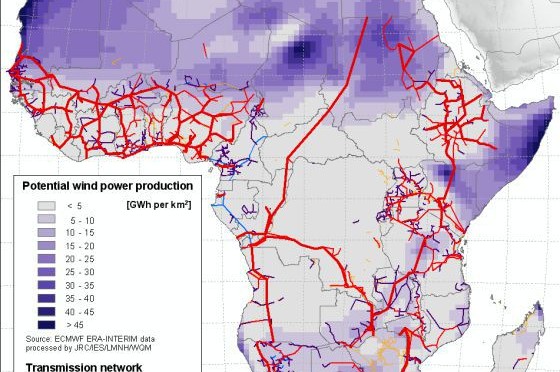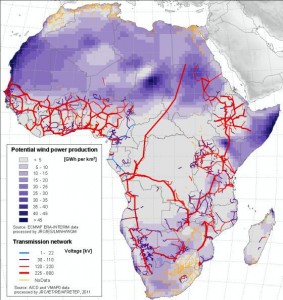As the only country in North Africa without significant proven hydrocarbon reserves, Morocco has consistently backed the construction of wind and solar energy projects. It was the fourth biggest investor in renewable energy in relation to the size of its GDP in the world last year.
The government’s latest targets aim to boost the proportion of renewables in the generation mix to 42% by 2020 and 52% by 2030, although this does include large hydro. Between 2021 and 2025, 1,100MW of solar capacity, 1,000MW of wind and 450MW of hydro are due to come on stream. Perhaps the greatest sign of confidence in the Moroccan wind power sector is Siemens decision to open a turbine factory at Tangier Automotive City next year, including to supply 2.3MW rated turbines to the Tarfaya project.
Announcing the project, Siemens Wind CEO Markus Tacke said: “Morocco is the perfect location from which to serve the growing onshore wind power markets in Africa, the Middle East and Europe. The economy is strong, the political climate is stable, and Morocco has a young, skilled and motivated workforce. These factors make Tangier the ideal site for this new state-of-the art factory.”
Some of the output will be exported from the nearby port of Tanger Med but Siemens has said that the growth of the local market was critical in its decision to locate the facility in Morocco. A similar factory is to be opened by Siemens in Egypt, which also has a growing wind power sector.
Alongside Enel Green Power and Nareva, Siemens is part of the consortium that has been named as the preferred bidder to design, build and operate five wind power projects spread across Morocco with combined capacity of 850MW, under 20-year build, own, operate and transfer contracts.
South Africa is vying with Morocco to be the biggest wind power producer in Africa. In February, commenting on the milestone of reaching half a million households, the CEO of the South African Wind Energy Association (SAWEA), Johan van den Berg, said: “Wind energy is still a relatively new industry in South Africa and what we have achieved in such a short time is a sure indication of how much more we can do.
“In 2011 there were just ten turbines in the country – now we have 13 large wind farms in operation, consisting of over 495 turbines, with many more under construction.”
In October, Enel completed the 88MW Nojoli wind farm in the Eastern Cape. It is the Italian firm’s first South African wind power project, although it already operates three large PV schemes with combined capacity of 158MW and has another 950MW of renewables capacity at various stages of development.
Just one month earlier, the 80MW Noupoort scheme in the Northern Cape was completed on schedule and on budget, with 35 turbines. It has been developed by the Mainstream Group, which already operates three other large renewable energy projects in the country and has another two wind farms under development.
While power utility Eskom may still rely heavily on coal-fired power plants, the country as a whole has rapidly embraced its renewable energy potential. South Africa’s Windaba wind energy conference, which is organised by the South African Wind Energy Association (SAWEA), was due to take place as this issue of African Business hit the newsstands.
SAWEA CEO Johan van den Berg said: “We are confident that South Africa will build a 30,000MW wind industry in the next 30 years irrespective of short-term development. If we want to optimise job creation, manufacturing and local content, this expansion needs to be steady and well communicated.”
However, there are signs that wind power could be overshadowed by solar energy in South Africa in the near future. Windpower Monthly magazine has reported research by Bloomberg New Energy Finance (BNEF) showing that the gap between solar and wind power prices was narrower in South Africa than in a number of other key countries in the first half of 2016, with $95/MWh for solar PV and $93/MWh for wind.
BNEF analyst Ethan Zindler told the magazine: “This would suggest that as PV module prices continue to fall, it would be South Africa where the LCOE [levelised cost of energy] for PV would be first to cross that for wind.” This is partly a function of the relatively high cost of wind power in South Africa but also a result of the relatively low cost of South African solar power, including in comparison with China and Germany.
The biggest sign of wind power’s entry into the African energy mainstream is the fact that projects are now been financed beyond the northern and southern fringes of the continent. The Overseas Private Investment Corporation of the United States has signed a deal to provide $250m to fund the construction of the 158MW Taiba N’Diaye wind farm in Senegal by Lekela Power, a new Pan-African renewables company.
Lekela is jointly owned by Actis and Mainstream Renewable Power and already operates 1,300MW of wind and solar power generating capacity. The International Finance Corporation, Elicio of Belgium and Kenya’s own Kenwind Holdings have finally been given the go-ahead to develop a 90MW wind farm in Kenya’s Lamu County at a cost of KSh21bn ($207m), after a deal was reached on the relocation of affected residents.
Speaking in September, Lamu deputy governor Eric Mugo told journalists: “No one has ever opposed the wind power project. Our only problem was on how well our people’s interests were going to be addressed especially the issue of compensation. I understand we had problems of communication but we have reached a consensus with the investor.”
Progress is also being made on the 310MW Lake Turkana Wind Power project. More than 150 of Vestas’ 850kW wind turbines had been erected by October, with part of the $700m funding also dedicated to constructing a transmission line to connect the project to the national grid.
Google is to buy a 12.5% stake in the scheme when it is completed next year. KenGen plans its own 400MW wind farm in Meru County, with work on the first 80MW phase due to begin next year.
Neil Ford
http://africanbusinessmagazine.com



